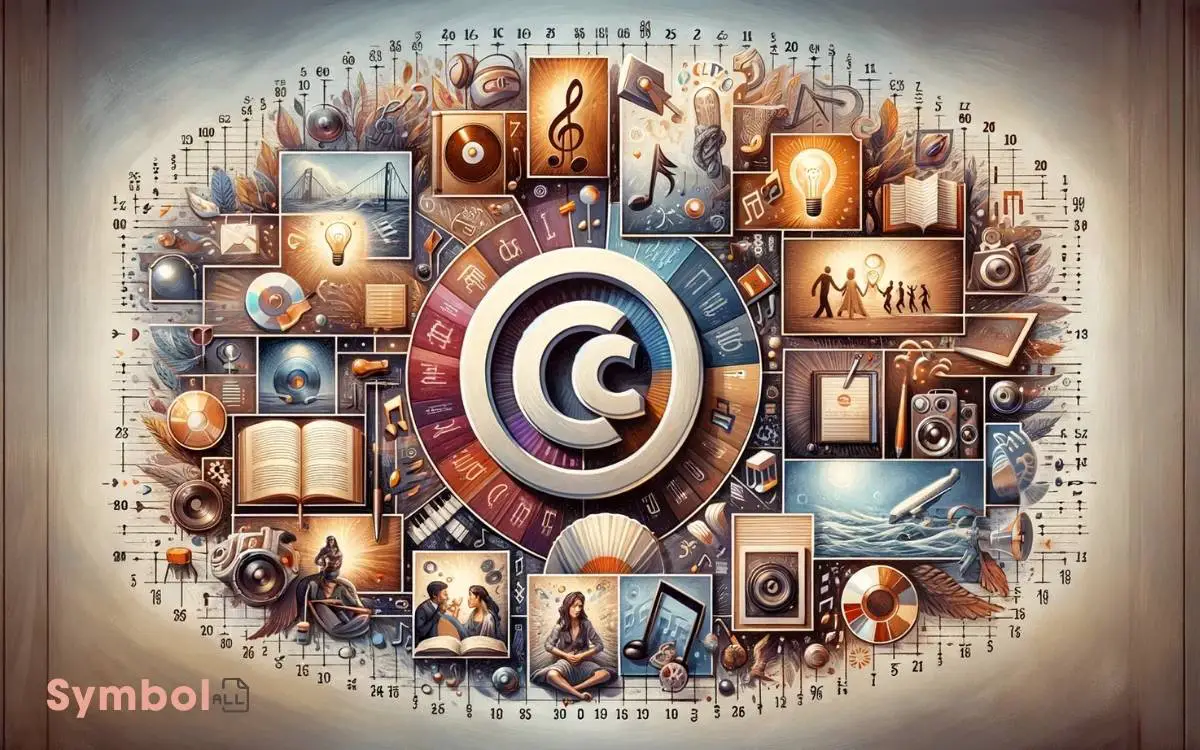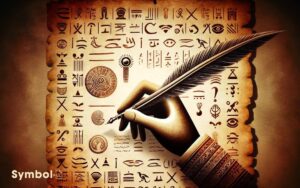When to Use a Copyright Symbol? Original Work!
You should use the copyright symbol whenever you create original work, such as literature, music, art, photographs, software, or videos.
This symbol asserts your ownership and signals your exclusive rights to use and distribute your creation. It’s not mandatory for copyright protection, but it helps deter unauthorized use and supports enforcement if infringement occurs.
Apply this symbol in publishing, online sharing, distribution, and even on social media to ensure your creations stay protected across borders.
Understanding the nuances of how and when to use this symbol properly can significantly enhance the protection of your intellectual property. By exploring deeper, you’ll discover even more ways to safeguard your work. This includes recognizing not only the legal implications but also the design and branding aspects that make your creations unique. For instance, learning how to use SF Symbols effectively can add a polished, professional touch to your digital projects while maintaining consistency. By combining strategic design choices with robust protective measures, you can ensure your intellectual property remains both visually appealing and secure.

Key Takeaways
Understanding Copyright Basics
Before delving into the specifics of using a copyright symbol, it’s crucial to grasp the fundamental principles of copyright law itself.
You must understand that copyright is a form of intellectual property protection granted by law to the creators of original works.
It automatically protects your work from the moment it’s created and fixed in a tangible form that’s perceptible either directly or with the aid of a machine or device.
This means your creations are protected without the need for registration or the use of a copyright symbol. However, understanding the symbol’s proper use can enhance the protection of your work by clearly indicating your rights and deterring potential infringement.
It’s essential knowledge for anyone creating original content.
Original Works Protection
To ensure your creative endeavors are safeguarded, it’s crucial you understand what constitutes an original work. Copyright basics lay the foundation for protecting your unique creations from unauthorized use.
Defining Original Works
Original works, encompassing creations such as literature, music, and art, receive protection from the moment of their creation under copyright law.
It’s crucial you understand what qualifies as an original work. Essentially, it’s any expression of ideas that’s fixed in a tangible medium. This means your creation doesn’t have to be published or registered to be protected.
However, the work must originate from you and show a minimal degree of creativity. It’s not enough for it to be an idea; it needs to be expressed in a form others can perceive.
This protection automatically applies, safeguarding your rights against unauthorized use. Remember, originality is key; your work must be the result of your creative effort and not copied from others.
Copyright Basics
Understanding the basics of copyright protection is essential for ensuring your original works are safeguarded from unauthorized use.
Once you create a piece of work be it literature, music, art, or software it automatically gains copyright protection. This means you’ve got the exclusive right to use, reproduce, and distribute your creation.
However, it’s crucial to note that copyright doesn’t protect ideas, concepts, or methods of operation; it only covers the tangible expression of those ideas.
To strengthen your position against potential infringement, you should consider registering your copyright. Registration makes it easier to prove ownership and enforce your rights in court, should the need arise.
Publishing Written Content
When publishing written content, it’s crucial to be aware of the legal requirements and protections that come into play.
Your work automatically gains copyright protection the moment it’s created and fixed in a tangible form that’s perceptible either directly or with the aid of a machine or device.
Using the copyright symbol (©), along with the year of first publication and your name, signifies to others that you hold the exclusive rights to your work.
This includes the right to reproduce, distribute, and adapt your writing. It’s a clear, legal declaration that deters potential infringement and provides a basis for legal action if your copyright is violated.
Sharing Photographs Online
When you share photographs online, you must understand the legal implications to protect your work effectively. Familiarizing yourself with best practices ensures your rights aren’t infringed upon by others.
This knowledge guards against unauthorized use and maintains your control over how your images are distributed and used.
Legal Implications
Sharing photographs online can expose them to copyright infringement risks, necessitating a clear understanding of legal protections. When you upload a photo, you’re essentially granting the platform a license to use it, though specifics vary by site.
However, this doesn’t strip you of your copyright. You retain the right to control how your work is used beyond the platform. Unauthorized use by others can lead to legal action on your part.
It’s crucial you’re aware that your photographs are protected from the moment of creation, without needing to display a copyright symbol. Yet, enforcement is on you.
If your work is misused, you’ll need to prove ownership and potentially pursue legal remedies, which can range from a cease and desist letter to litigation.
Best Practices
How can you ensure your photographs are protected when sharing them online?
First, always apply a visible but unobtrusive copyright watermark on your images. It’s a clear indicator of ownership without significantly detracting from the photograph’s aesthetic.
Additionally, consider using lower-resolution versions for online sharing. This deters unauthorized use while maintaining enough quality for viewing.
You should also familiarize yourself with the privacy settings on various platforms. Platforms like Instagram and Facebook offer settings that can help control who sees and shares your work.
Most importantly, don’t forget to explicitly state your copyright notice in the image description. It’s a straightforward step, but it reinforces your legal claim to the work, making it harder for others to misuse your photographs without repercussions.
Distributing Music and Audio
Distributing your music and audio effectively requires a thorough understanding of copyright symbols to protect your work. When you create original music or audio content, it’s crucial to use the copyright symbol © immediately followed by the year of creation and your name.
This simple action asserts your copyright, signaling to distributors and users alike that you own the content. By marking your work, you deter unauthorized use and gain leverage in enforcing your rights.
Remember, copyright exists from the moment of creation, but displaying the symbol is a proactive step in safeguarding your intellectual property.
It’s essential, especially in digital spaces where content can easily be shared or repurposed without permission. Always ensure your music carries this symbol before distributing it to the public.
Copyright for Digital Art
As you step into the realm of digital art, it’s imperative to understand how to safeguard your creations. Protecting digital works requires a keen awareness of copyright laws and strategies to navigate online infringements effectively.
You’ll need to be vigilant and proactive to ensure your digital art remains under your control.
Protecting Digital Creations
In the digital age, protecting your digital art with copyright ensures your creative works remain solely under your control. You’re the creator, and it’s crucial to understand your rights and how to enforce them.
Copyright secures your digital art from unauthorized use or distribution, providing you with legal ground to challenge infringements.
| Action | Benefit |
|---|---|
| Registering Copyright | Legally establishes your ownership |
| Using Copyright Symbol © | Signals your rights to the public |
| Publishing with Metadata | Embeds ownership details in your art |
| Drafting Terms of Use | Sets rules for how others may interact |
| Monitoring Use Online | Identifies unauthorized reproductions |
Embrace these strategies to shield your creations. It’s about safeguarding your rights and ensuring your digital art remains your valued asset.
Navigating Online Infringements
Discovering your digital art has been used without permission can be unsettling, but knowing how to navigate online infringements empowers you to take action.
First, document the infringement by taking screenshots or saving URLs where your art’s been misused. This evidence is crucial.
Next, reach out directly to the offender with a cease-and-desist letter. It’s often the fastest way to resolve the issue. If that doesn’t work, you can file a DMCA takedown notice with the hosting service or platform.
Remember, you’ve rights under copyright law, and most platforms have procedures to support creators.
Lastly, consider registering your works. While not required, registration bolsters your legal standing, making it easier to enforce your copyright and potentially claim damages.
Stay informed and proactive to protect your digital creations effectively.
Software and Code Copyright
You must understand that copyrighting software and code protects your creative programming work from unauthorized use or distribution.
Here’s how you should approach it:
- Identify the Copyrightable Material: Not all parts of your software may be eligible for copyright. Focus on the original, creative aspects.
- Document Your Work: Keep thorough records of your development process, including dates and versions.
- Apply the Copyright Symbol: Once your software is created, add the copyright symbol, your name, and the year of creation to your software documentation and user interface.
- Register Your Copyright: While not mandatory, registration provides legal benefits, including the ability to sue for infringement and potentially recover damages.
Grasping these steps ensures your software remains your intellectual property, securing its value and your rights as its creator.
Video Content and Copyright
Just as with software and code, protecting your original video content from unauthorized use demands a clear understanding of copyright laws.
When you create a video, you’re automatically granted copyright protection over your creation. This means you have the exclusive right to use, distribute, and modify your work.
However, applying a copyright symbol ©, along with the year of creation and your name, clearly communicates your ownership and deters potential misuse.
It’s crucial to note, though, that copyright doesn’t cover ideas or concepts within your video, only the expressive form they’re presented in.
Therefore, if you’re sharing unique methods or storytelling, consider additional protections like trademarks or patents. Understanding these nuances ensures your creative outputs are fully safeguarded.
Copyright in Social Media
Navigating copyright in the realm of social media requires an acute understanding of how your content is protected and shared online.
Here’s what you need to keep in mind:
- Original Content Creation: Anything you create and post is automatically copyrighted to you. This includes photos, videos, and text.
- Sharing Others’ Content: Always seek permission or use content marked as free to use. Crediting isn’t enough if the content isn’t free to share.
- Use Copyright Symbols: Indicating your work is copyrighted can deter unauthorized use. Include © with the year and your name for clarity.
- Reporting Infringement: If you find your work used without permission, report it to the social media platform for removal.
Understanding these key points ensures your creations remain protected while navigating the complex landscape of social media.
Navigating International Copyright Laws
While understanding copyright protection on social media platforms forms the foundation, it’s equally important to grasp how these rights extend and are recognized across different countries. You’ll find that copyright laws aren’t uniform worldwide; they vary significantly.
Fortunately, the Berne Convention for the Protection of Literary and Artistic Works ensures your creations are protected in all 179 member countries without needing to register separately in each. However, nuances exist.
For instance, the duration of copyright protection can differ life of the author plus 50 to 70 years is common, but specifics vary.
Always check the local laws when you’re looking to enforce your rights internationally. Ignorance isn’t bliss in this realm; it’s your responsibility to know and understand how your copyrights are protected globally.
Conclusion
So, after delving deep into the quagmire of copyright laws, you’ve realized it’s a labyrinth, haven’t you? Here’s the irony: in our quest to protect our creations, we’re armed with a simple © symbol – a shield against the giants of theft and misuse.
Yet, navigating its use is as straightforward as solving a Rubik’s Cube blindfolded. But fear not, armed with this knowledge, you’re now a gladiator in the digital arena. Use your © wisely, and let your creations thrive under your vigilant watch.






